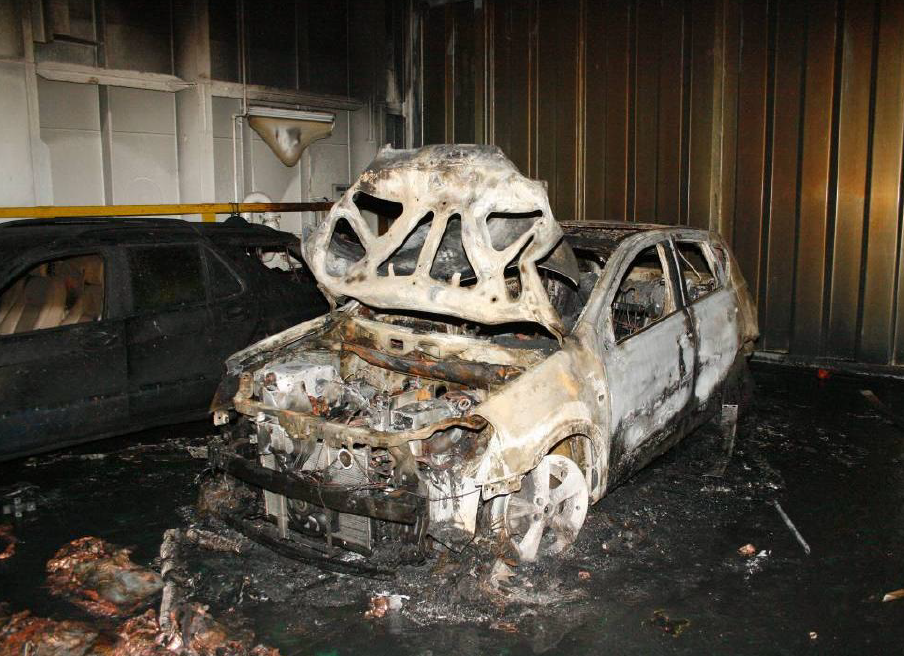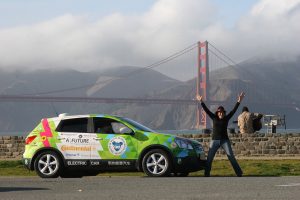In 2010 my electric vehicle conversion company AFUTURE EV had an accident with one of our cars catching fire on the Oslo ferry Pearl of Scandinavia. The accident ended up bankrupting AFUTURE EV, due to the insurance provided denying to pay despite being sued by the ferry company.
I was onboard, after having helped the vehicle go through a Norwegian type approval check, so decided to do damage control before too many rumors about faulty electric car technology would spread – this is the full story.

(Picture: Please know that the hood was not blown up, but opened by the firefighters – there was no explosion due to the vehicle’s safety features.)
The car was of the type AFUTURE EV200 built on the 2009 Nissan Qashqai, the same type which was already then on the record-setting Electric World Tour, and at the time they were also used by Better Place and Dong in Denmark.
Early lithium-battery electric cars like these had a higher risk of catching fire due to battery overheating than more modern electric cars have, but still the risk was on average lower than for gasoline cars.
This particular car had just been on a promotion and type approval trip to Norway, charging under rigorous conditions many times during the previous days, and had shown no signs of trouble, except as expected for the tests – it entered the ferry the 16th of November around 17:00 with 2% charge, and was plugged in for charging (we had asked the ferry company for this in advance) without problems – charge was set at one phase, 220V, 6A to not overload any fuses on the ferry.
We had many safety features on the EV200 cars, as well as remote surveillance on them, and for that reason my girlfriend, her service dog and I also slept well in our cabin when the fire alarm sounded for a short time at around 0553. At that point I got up and talked to the receptionist, who said it was a minor fire on the car deck, but already under control. I told them we had a quite expensive electric car that the steel bulkheads blocked me from getting status from, but I was told the fire was in an entirely different bulkhead so went back to sleep without worries.
Some ten minutes later the fire alarm sounded continuously, and my girlfriend, our dog and I got up on the top interior deck as instructed by personnel, and spent the night there until we made it to the harbor. In the mean time fire fighters from Norway had flown in with helicopter and secured the situation. Happily none were seriously hurt by the accident.
As we were about to exit the ferry I was called to the car deck (due to the license plate being registered with my company), and there helped the fire fighters and police with investigating the fire, after having talked with my board about how to deal with the situation ones journalists arrived – we decided to do a media damage control to avoid harmful rumors, until the situation could be properly investigated:
As such I took the first possible explanation outside the car and went with it; that the extension cord used had been faulty and caused the fire – it was an adapted Norwegian connector, had been burned over, was not water proof and lay in a pool of oily water; lot’s of chances that this was the cause of the fire.
The media took the bait, and I took the blame – and that almost saved the company, together with the fact that the Electric World Tour was well underway and a success so international attention rather focused on the cars great abilities than the unfortunate fire.  So, ironically but due to good damage control, the ferry fire earned AFUTURE EV more customers than we lost on it.
So, ironically but due to good damage control, the ferry fire earned AFUTURE EV more customers than we lost on it.
What I later learned, was that due to unlucky placement and errors among the crew, they first only doused an area of trucks on the other side of the bulkhead with the water sprinklers, because they believe the fire was there. For this reason the EV200 (placed in its own bulkhead together with a single other car and semi trailer) was allowed to burn unhindered for almost 10 minutes, and then continued to burn afterwards due to the accumulated heat – had cooling with the water been applied earlier the fire would have been far less hot and then caused only minor damage to the car itself, until the battery had run out of energy after perhaps 30 minutes of smoldering, if the massive cooling could not put out the run-away battery, or avoided thermal run-away entirely… and the extension cord had simply been burned by the flames from the battery pack, when the extreme heat disintegrated the armored battery box.
It took 1.5 years of investigation to get through the vehicle and all the possible reasons for the fire – and in the end nothing in particular was found, except that it originated somewhere in the battery pack. I have my own guesses, but that is all they are – guesses. The report from the fire authorities can be seen here.
Sadly, due to the insurance provider TRYG denying to cover the damages to the ferry under our company insurance, despite the kasko insurance covering the vehicle, the incident bankrupted AFUTURE EV. This was long before the court case against the insurance company was given up by the ferry company DFDS Seaways – we from AFUTURE EV sided with the ferry company, even after we had no longer any monetary interests in the case, but in the end the case was dropped due to risking becoming more costly than the damages.
A loyal employee ended up buying the estate from the AFUTURE EV bankruptcy, making use of the new customers, and the remains of the company, the documentation and the expertise were in 2016 sold to Mobility and Energy Group.
